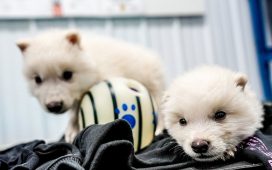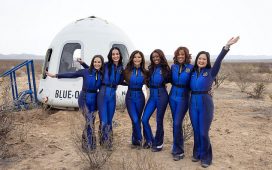Peter Eliopulos, 4, worked with the spaghetti and small marshmallows placed on a table by Russell Construction in the gymnasium at Bettendorf Middle School.
Peter made several construction designs with the simple materials, occasionally looking at what other children were building, but mostly concentrating on his own design.
Peter Eliopulos, 4, builds with spaghetti and mini marshmallows at the Russell Construction exhibit table at the STEAM Expo held Saturday at Bettendorf Middle School.
“He likes to do stuff like this, but he’s never worked with these materials before,” Peter’s father Sam Eliopulos said of his son. “This is the longest we’ve stayed in one spot today. He’s really enjoying it.”
Peter and his father were among 600 people who attended the STEAM Expo on Saturday that ran from 11 a.m. to 2 p.m. at Bettendorf Middle School.
There were 32 stations throughout the school where adults and children could learn about a subject in science, technology, engineering, the arts and mathematics.
People are also reading…
Children partake in spinning art at the STEAM Expo held Saturday at Bettendorf Middle School.
Lee Marbach, a project manager with Russell Construction, said the exercise using the simple ingredients is “really just about experimenting and trial and error and that engineering concept of instead of being the right answer how do you continue to try and learn and improve. The idea is if they want to build the tallest tower, how does that happen?”
As he watched the children build, Marbach said that “there are studies that show that in this spaghetti and marshmallow example children outperform adults consistently because the children aren’t afraid to try new things and trial and error.”
HNI Corporation, an office furniture manufacturer in Muscatine had three robots set up for the people to drive. Cones to maneuver around were set up for one of the robots, while a curved roadway was set up for another. The third robot was used to push a box around.
Kids and adults lined up to drive the robots.
Ryker Kulig, 13, puts a robot through its paces at the HNI Corporation’s robot exhibit at the STEAM Expo held Saturday at Bettendorf Middle School.
Kandice Tjebkes, an industrial engineer out of the University of Iowa who has been with HNI for 27 years, said the robots are very popular.
“We have a Women in STEM group. and we do school outreach for bringing up the next generation in STEM,” Tjebkes said. “We partner with the Fire Island Robotics Team from Muscatine High School. and they make these robots that we take around to the schools.
“These have been very well-received, and we do them from kindergarten through grade six,” she added. “When the kids take a tour of our factories, they can then see the big robots pushing the boxes around.”
Bettendorf Police Lt. Andrew Champion and police officer Eric Poirier were showing how science and technology are used by police. They had a baseball throw set up and were clocking the speed of the balls using a hand-held radar.
Bettendorf Police Lt. Andrew Champion, with radar, clocks the pitch of Kenzie Caughey, 12, during the STEAM Expo held Saturday at Bettendorf Middle School.
“This is the third year we’ve done the speed measurement with the radar,” Champion said. “We try to represent a ball speed to a vehicle speed because they’re very typical of what in-town speeds would be and it just helps kids equate to that.
“The radar is using a light wave to bounce off the baseball and it slows kids to see how the technology can be used in different ways,’ he added.
Amid all the science and technology were the arts, including writing and the use of one’s imagination.
“Sarah Elgatian, marketing and programs director for the Midwest Writing Center, pointed out that, “Nothing we do in our leisure time is not written.
Dave Marcia, Director of the Wapsi River Environmental Education Center, shows off the wing span of a great horned owl during the STEAM Expo held Saturday at Bettendorf Middle School.
“The TV shows are written, the video games are written, the music is written, the books are written,” she said. “There’s no escaping the written word. It’s just remembering that’s where it all came from.”
Addie Cartner, 10, operates a virtual John Deere excavator during the STEAM Expo held Saturday at Bettendorf Middle School.
There was more to see and do, with many of the families saying they come every year.
Among the many activities included Mike McKean of the U.S. Army Corps of Engineers teaching children about how the locks and dams work on the Mississippi River. Dave Marcia, Director of the Wapsi River Environmental Education Center had a great horned owl that he used to teach children about the raptors. St. Ambrose University had their physical therapy and chemistry students teaching different aspects of science.
Mike McKean of the U.S. Army Corps of Engineers explains to Ezra MacManus, 5, how the locks and dam systems work on the Mississippi River.
Parker Audiology taught about the world of ear wax, Metronet taught about fiber optics, John Deere had welding, while the Quad-City Steamwheelers taught people how to throw a spiral pass. There was slime fun with the Bettendorf Girl Scouts, while the Boy Scouts had several exhibits including lighting cotton balls on fire using flint and steel.
There also were exhibits on gardening, the watershed, veterinary medicine, screen printing, beekeeping, clean energy, and a planetarium show, among many others.
Oscar Magnuson, 9, uses a flint on steel to spark a fire on a cotton ball during the STEAM Expo held Saturday at Bettendorf Middle School.
Griffin Rindler, 7, and Easton Wille, 6, were in the 3M room making bouncy balls.
Joshua Varghese of 3M said they were there to teach the children about polymers and density and solubility by making bouncy balls and lava lamps.
To make the bouncy balls, he said, they use water, glue, borax and corn starch.
Morgan Keppy, 12, left, and Lilli Diericks, 11, see their balloons expand after baking soda is mixed with vinegar at the chemistry exhibit at the STEAM Expo held Saturday at Bettendorf Middle School. The chemistry exhibit was hosted by the St. Ambrose University.
Holding a string of small beads, Varghese explained that “these beads represent our short chain polymers, which is our glue and corn starch solution, and when we mix these with borax and water you get longer chain polymers, and that gives it different properties and that makes it less slimy and bouncy.”
The lava lamps were made with water, vegetable oil and food coloring. When antacid tablets were dropped into the mixture, it made for a show that wowed the children.
Steven Beard, a Genesis nurse who also is a beekeeper in Davenport with his wife, Marlo, a Monmouth College professor, explains all about bees and beekeeping during the STEAM Expo held Saturday at Bettendorf Middle School.
Rachael Diericks, an MTSS facilitator, or multi-tiered system of supports, for the Bettendorf Community School District said bringing together businesses and service organizations to talk about their varied work allows the days guest to see “where all of these categories fit into life and help our students see there are a lot of opportunities to apply what they’re learning in the classroom in the real world.”










